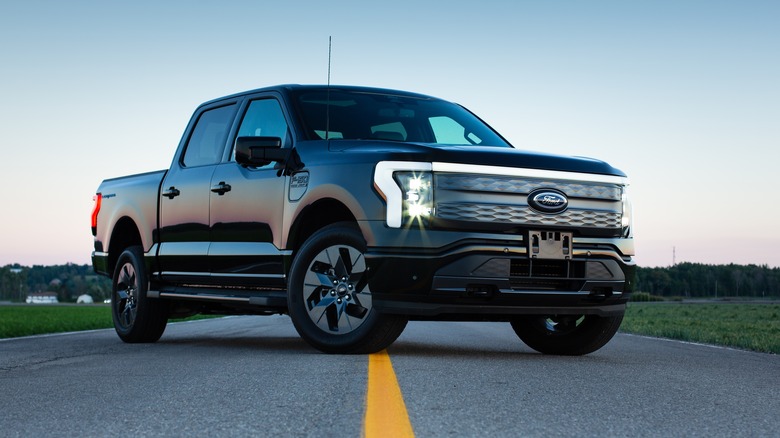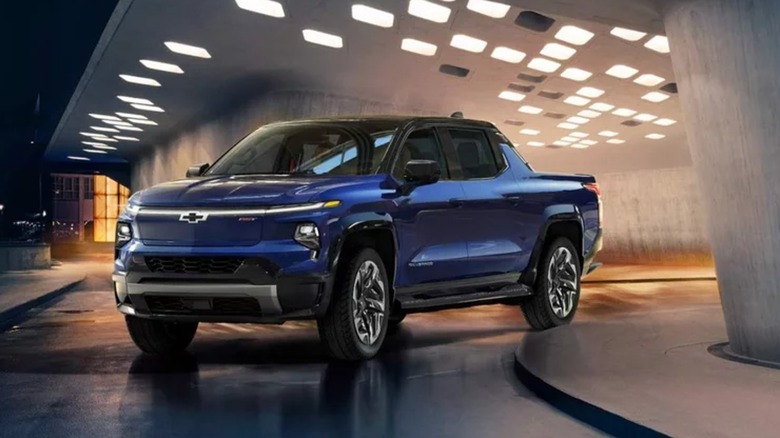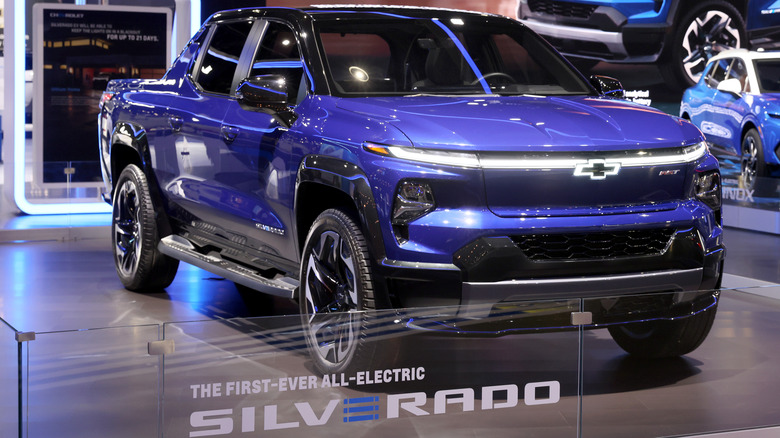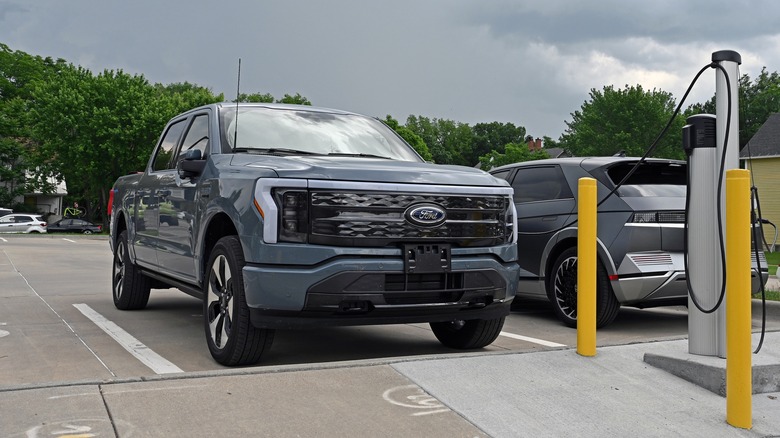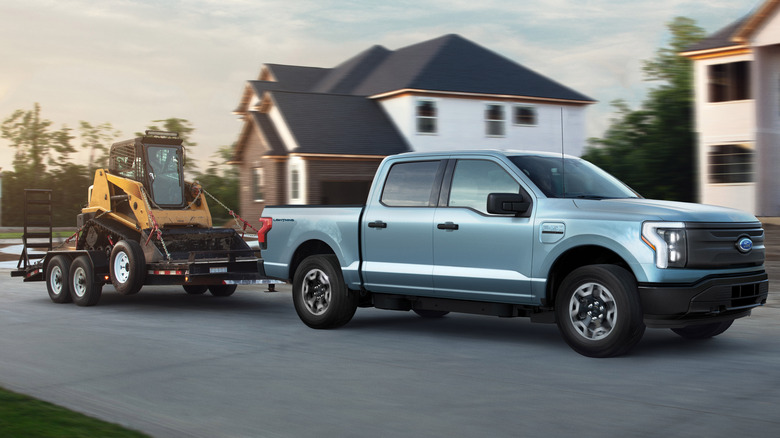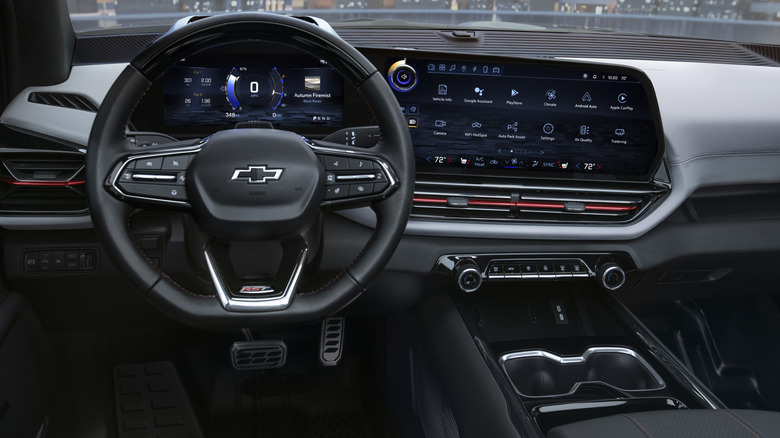2024 Ford F-150 Lightning Vs. 2024 Chevy Silverado EV: Which EV Is Worth Your Money
General Motors has made no secret of its plans to dominate the EV market in the same way it has in ICE production for well over a century. Earlier this year, it overtook Ford to become the second-biggest EV seller in the country. Part of GM's strategy is to offer a wide variety of electric vehicles, rather than focusing on a small handful of models.
One of those models will be the 2024 Chevy Silverado EV, which GM is introducing later this fall. The Silverado isn't just any EV either — it'll be one of the vanguard models of a legacy automaker diving head-first into electrification. Electric trucks are vital to the automotive market's transition from ICE to electric, and GM isn't the only company aware of this. The 2024 Chevy Silverado EV is a direct rival to Ford's electric F-150 Lightning. Ford, too, has fully embraced going electric and its F-150 Lightning has been crucial in winning over life-long Ford enthusiasts while convincing them to ditch ICE once and for all.
So how will the 2024 Chevy Silverado compare to the Ford F-150 Lightning, which has been in production since spring 2022? How they stack up against each other could be indicative of how the overall EV battle between Ford and Chevy may play out over the next decade and beyond.
Both trucks are pricier than originally promised
Both the Ford F-150 Lightning and Chevy Silverado EV have price tags that are a lot higher than they were originally promised years before either began production. Considering the precarious state of the economy and consistent supply chain issues over the last few years, that's no surprise, but neither truck could be called affordable at this point.
Thankfully, prices seem to be coming down. The 2024 Ford F-150 Lightning is around $10,000 cheaper than last year, depending on the model. While still far higher than the original cost Ford had announced years ago, that means you can pick up a basic Ford F-150 Lightning EV for $49,995. However, that cost can nearly double if you opt for a more luxurious model like the Platinum Extended Range.
Prices haven't been locked in yet for the 2024 Chevy Silverado — as of right now, it's unknown how much exactly the truck will cost. Its basic work truck model could end up as low as $39,900, however, while its decked-out RST First Edition will likely run for $105,000. The Silverado EV will roll out with only two trim models at first, so there won't be many different price points in between.
Chevy has the edge when it comes to its engine
The Ford F-150 Lightning EV lives up to its name because not only does it have the heft of a pickup truck — it's also fast. While the exact specifications of the 2024 model are still unclear, it'll likely compare or surpass the 2023 model. The Pro, XLT, and Lariat trims of the 2023 F-150 are equipped with dual electric motors that can generate 775 lb-ft of torque and 452 horsepower, while a larger battery pack can give the XLT, Lariat, and Platinum models 580 horsepower. The Platinum is capable of at least 0 to 60 mph in less than four seconds.
The Chevy Silverado RST First Edition EV is no less than a beast with dual electric motors that give it 785 lb-ft of torque and a whopping 754 horsepower. With that kind of juice under the hood, Chevy claims the Silverado is able to go from 0 to 60 mph in 4.5 seconds. When compared to the F-150's Pro, XLT, and Lariat models, the Silverado WT's powertrain outpaces them with 510 horsepower but has a slightly lower maximum torque at 615 lb-ft.
The Silverado's battery can draw more power and last longer than the F-150
If battery range is the deciding factor for you when choosing an electric truck, then you'd be remiss not to go with the 2024 Chevy Silverado EV. The vehicle has an estimated range of 450 miles, which is 150 more than what the best Ford F-150 Lightning — the Platinum with an extended-range battery — can muster.
Add in the fact that the Silverado, which comes with a Combined Charging System (CCS) plug, will adopt Tesla's North American Charging Standard (NACS) in 2025 and can use adapters, and it shouldn't be too hard to find a charging station as you near that 450-mile mark. The Silverado's 800-volt battery can draw 350 kW, the highest possible amount from current DC fast-charging stations, allowing the truck to charge up to 100 miles in 10 minutes.
While the Ford F-150 Lightning has an EPA-estimated range of 300 miles, it's managed to go 10% farther in real-world testing, but that still doesn't come close to the Silverado. Even its extended-range battery can only draw up to 155kW, less than half that of the Silverado. That does give Lightning drivers more options when it comes to fast-charging stations, however, since not all are capable of 350 kW. The Lightning's standard-range battery can charge 15 to 80% in about 36 minutes, while its bigger battery can do the same in 41 minutes. Ford is also adopting the NACS standard for its EVs starting next year.
The Ford F-150 Lightning has a bigger payload, but at a cost
Obviously, hauling and towing are important features for a pickup truck, and that includes electric models. Both the Ford F-150 Lightning and Chevy Silverado EV can tow up to 10,000 pounds, though GM says future versions of the Silverado will be able to handle double that. The F-150 Lightning does have a bigger payload than the Silverado, however. The Silverado's payload is rated at 1,400 pounds, whereas the F-150 Lightning can handle 2,235 pounds. However, Ford's number is less impressive when factoring in range because the added weight to the truck seems to have a big impact on its battery, with a reduction of at least 24.5 to 30 percent.
The Silverado hasn't been subject to as much field testing yet, but its battery will likely also strain under extra weight. Its larger capacity and longer range may help but won't necessarily solve the problem. On top of that, hitching a trailer to the truck can make it difficult to access many charging stations, which is another impediment. Even as EVs catch up to ICE trucks in many other areas, it seems for now that gas-guzzlers still have the advantage when it comes to towing and hauling.
The interior and safety features of both models are roughly the same
Both the Lightning and Silverado are spacious on the inside and more luxurious than you probably need for a work truck. The Lightning has dual-zone climate control, whereas the Silverado has no separate temperature control for the rear. Both vehicles have large digital gauges and a large infotainment screen at the center of each dash, though the screen on the Lightning is an inch bigger in diameter than the Silverado EV WT's.
The Lightning includes Apple CarPlay and Android Auto smartphone integration and wireless connectivity. The Silverado EV WT model comes with wireless Apple CarPlay and Android Auto as standard, as well as Google Assistant. Both have an integrated navigation system.
When it comes to protecting you and your passengers, both trucks have pretty similar safety features. Both have forward collision alert, automatic emergency braking, and lane-keeping assist. The Lightning has auto high beams and the Silverado has a high beam assist. As these features become more standard across the EV industry, it shouldn't be a surprise that both the Ford F-150 Lightning and Chevy Silverado EV are utilizing the latest advancements in safety technology.
